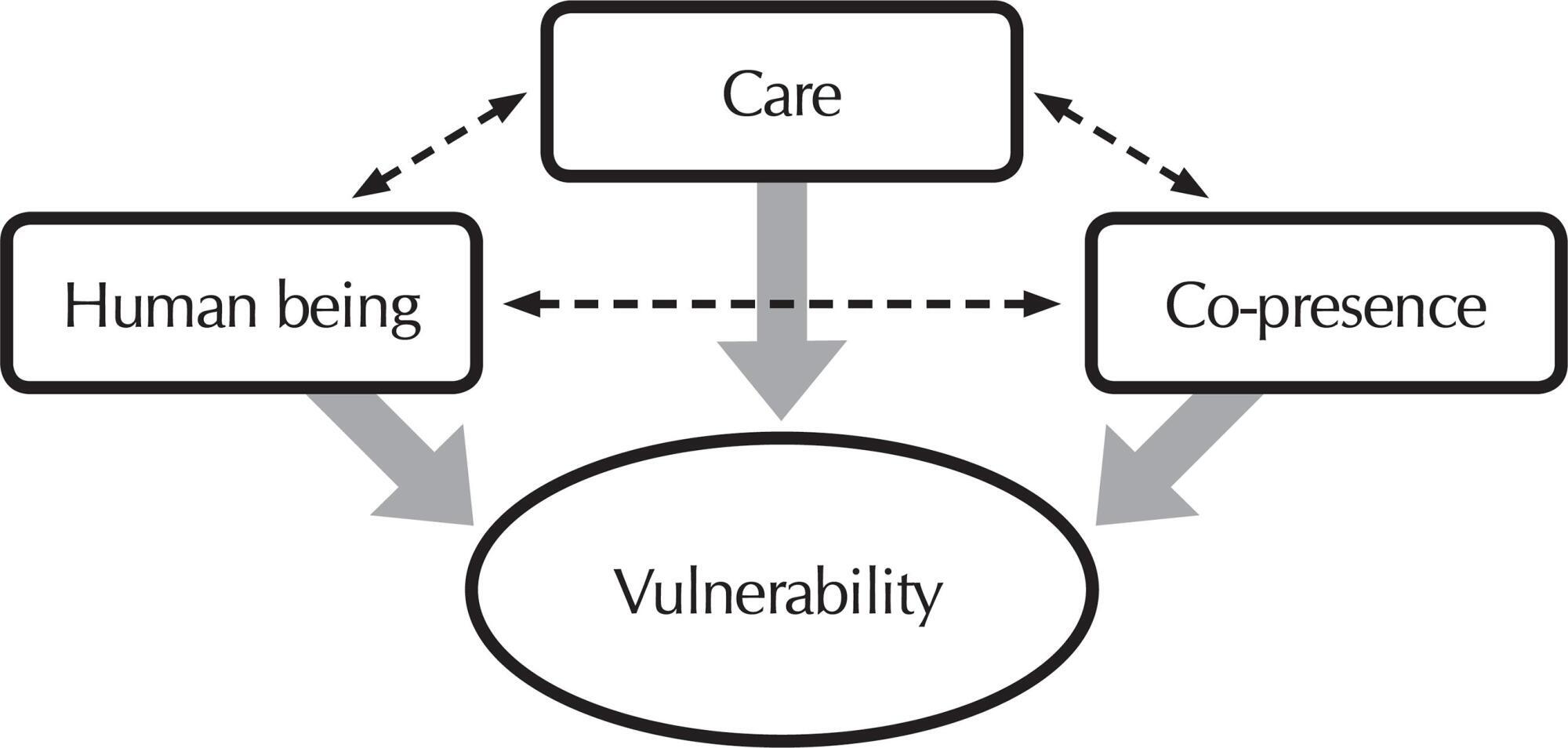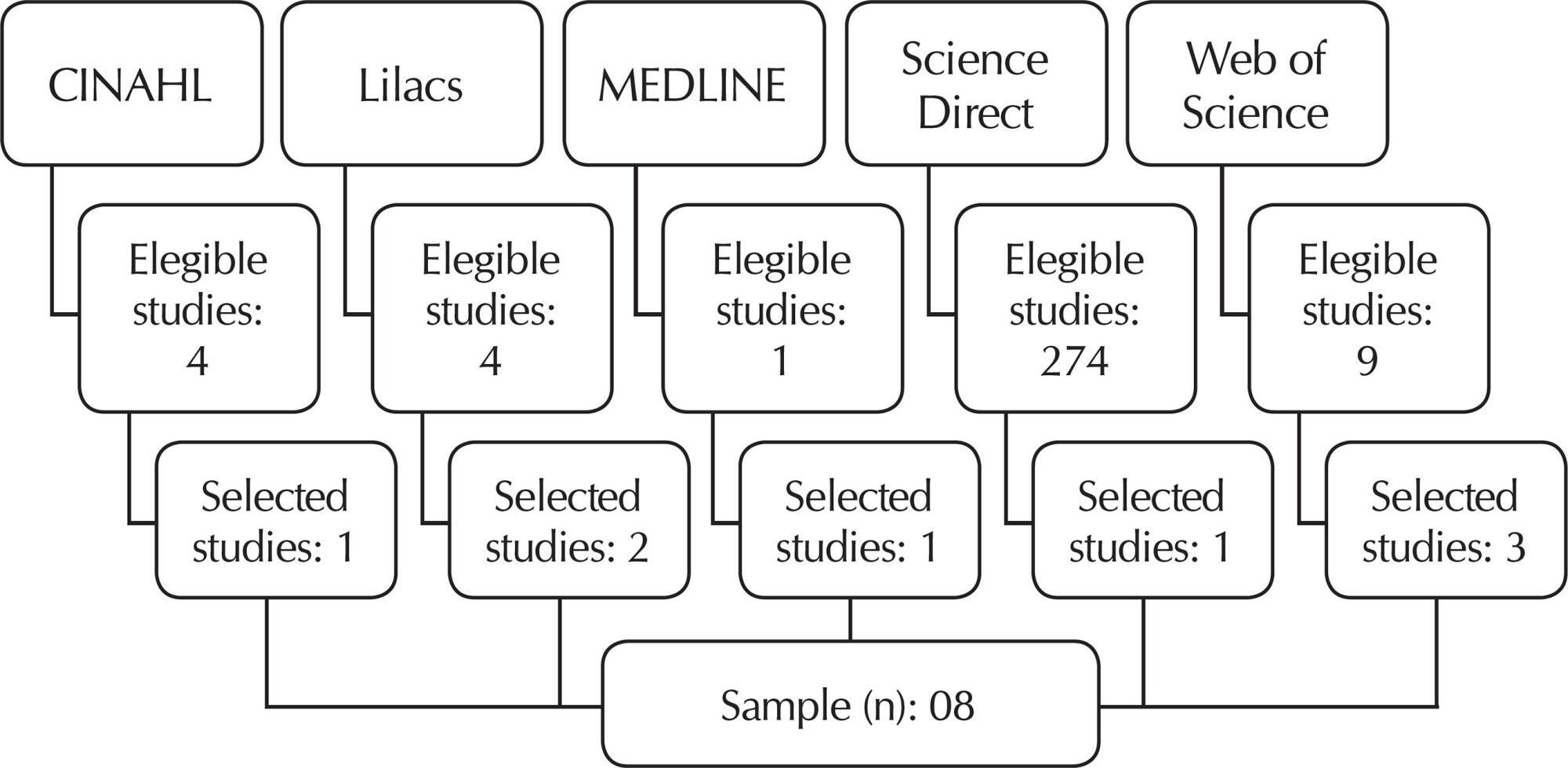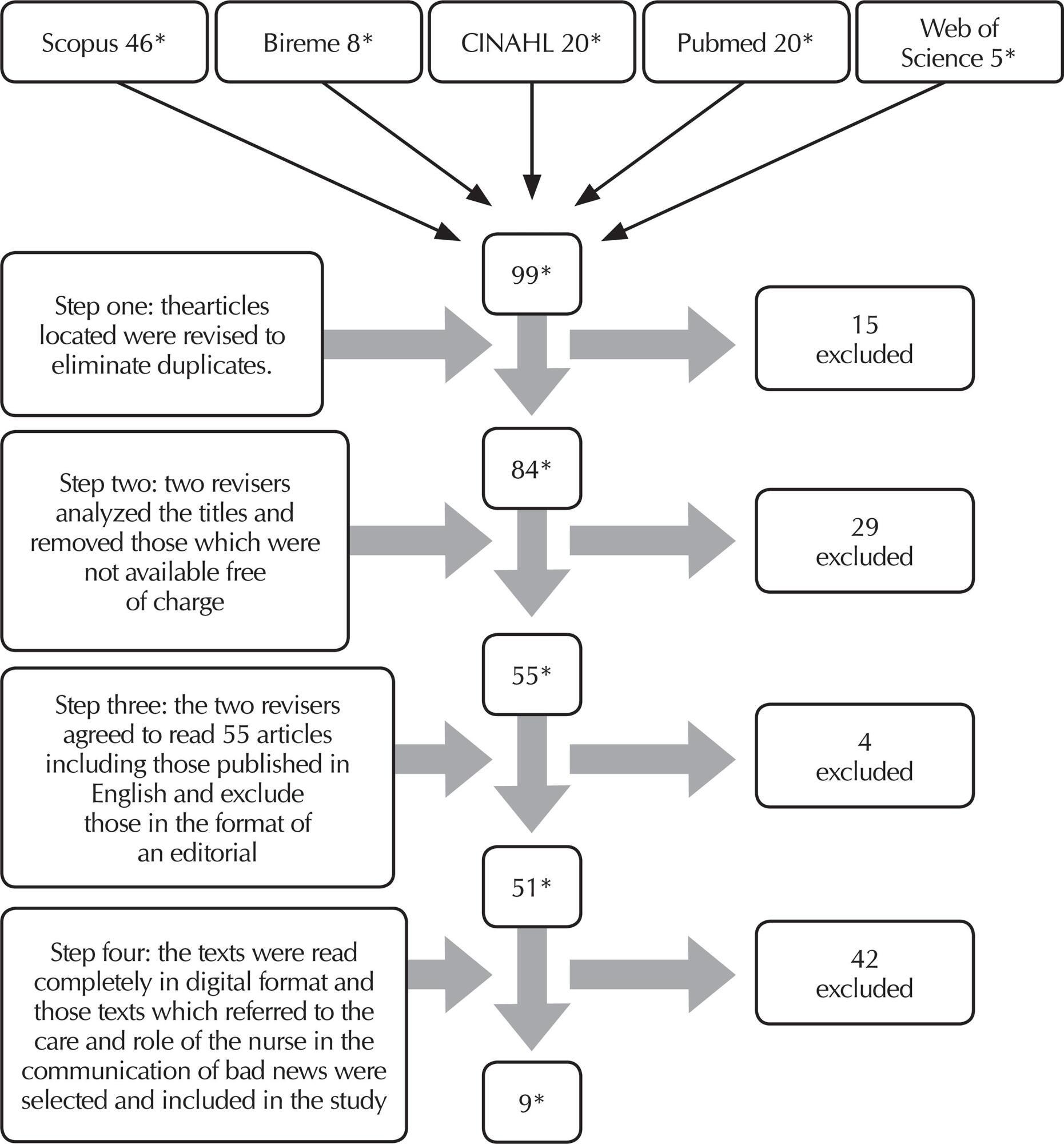-
REFLECTION01-01-2017
The essence of care in health vulnerability: a Heideggerian construction
Revista Brasileira de Enfermagem. 2017;70(5):1112-1116
Abstract
REFLECTIONThe essence of care in health vulnerability: a Heideggerian construction
Revista Brasileira de Enfermagem. 2017;70(5):1112-1116
DOI 10.1590/0034-7167-2016-0570
Views0See moreABSTRACT
Objective:
Reflect on the essence of care in health vulnerability from the phenomenological perspective of Martin Heidegger.
Method:
Theoretical-reflexive study, anchored in three essential parts: 1) Care in Heidegger; 2) The essence of care in health vulnerability; And 3) Nursing care actions on health vulnerability.
Results:
Vulnerability must be recognized as an indelible trait of the human condition and has its constituents in the human being, co-presence and care. Caring is an interactive process that reveals itself in the relationship with the other. Respecting the integrity of the Being in vulnerability must be a priority in nursing care, through behaviors that privilege the Being.
Conclusion:
Understanding ontological care and its relation to vulnerability under Heidegger’s phenomenological view allowed us to uncover the facets of care in health vulnerability by adding to the nursing knowledge body a comprehensive and reflective perspective.

-
REFLECTION01-01-2017
Nursing supervision for care comprehensiveness
Revista Brasileira de Enfermagem. 2017;70(5):1106-1111
Abstract
REFLECTIONNursing supervision for care comprehensiveness
Revista Brasileira de Enfermagem. 2017;70(5):1106-1111
DOI 10.1590/0034-7167-2016-0491
Views0See moreABSTRACT
Objective:
To reflect on nursing supervision as a management tool for care comprehensiveness by nurses, considering its potential and limits in the current scenario.
Method:
A reflective study based on discourse about nursing supervision, presenting theoretical and practical concepts and approaches.
Results:
Limits on the exercise of supervision are related to the organization of healthcare services based on the functional and clinical model of care, in addition to possible gaps in the nurse training process and work overload. Regarding the potential, researchers emphasize that supervision is a tool for coordinating care and management actions, which may favor care comprehensiveness, and stimulate positive attitudes toward cooperation and contribution within teams, co-responsibility, and educational development at work.
Final considerations:
Nursing supervision may help enhance care comprehensiveness by implying continuous reflection on including the dynamics of the healthcare work process and user needs in care networks.
-
REVIEW01-01-2017
Nursing knowledge and practices regarding subcutaneous fluid administration
Revista Brasileira de Enfermagem. 2017;70(5):1096-1105
Abstract
REVIEWNursing knowledge and practices regarding subcutaneous fluid administration
Revista Brasileira de Enfermagem. 2017;70(5):1096-1105
DOI 10.1590/0034-7167-2016-0424
Views0See moreABSTRACT
Objective:
To describe the evidence in the literature regarding the knowledge and practices of the nursing team about subcutaneous administration of drugs and fluids in adults.
Method:
Integrative review of the literature using the descriptors “nursing”, “hypodermoclysis”, “drug administration routes”, “adult health,” and “knowledge,” in English, Spanish, and Portuguese, with no publication deadline. Of the 569 articles found, eight made up the sample.
Results:
A predominance of international journals (75%) with more than five years of publication (62.5%). The analysis of the methodological characteristics showed a predominance of literature reviews (25%), quantitative studies (62.5%), cross-sectional studies (50%), and non-experimental studies (50%).
Conclusion:
Although it is an old technique with proven efficacy, hypodermoclysis is still little used, a puzzling fact due to its advantages and indications for any age.

-
REVIEW01-01-2017
Communicating bad news: an integrative review of the nursing literature
Revista Brasileira de Enfermagem. 2017;70(5):1089-1095
Abstract
REVIEWCommunicating bad news: an integrative review of the nursing literature
Revista Brasileira de Enfermagem. 2017;70(5):1089-1095
DOI 10.1590/0034-7167-2016-0143
Views0See moreABSTRACT
Objectives:
describe how the process of breaking bad news is established and identify how nurses approach the task of giving bad news.
Method:
integrative review of the literature for articles in Portuguese and English published between 1993-2014, in the databases: Bireme, PubMed, Scopus, Web of Science, CINAHL and Embase. Nine articles were included using the selection flow chart. A digital form was completed for each article according to the Consolidated Criteria for Reporting Qualitative Research checklist and the level of scientific evidence was determined.
Results:
Of the 99 articles in identified, nine were included after applying the selection flowchart.
Discussion:
breaking bad news is frequent in the area of oncology and palliative care, with a strong cultural influence on the autonomy of nurses in this process.
Conclusion:
the approach and skills of the nurse during this task influences the patient’s reaction to the message. The theme is scarce in the literature and merits further investigation.

-
REVIEW01-01-2017
Patient safety and nursing: interface with stress and Burnout Syndrome
Revista Brasileira de Enfermagem. 2017;70(5):1083-1088
Abstract
REVIEWPatient safety and nursing: interface with stress and Burnout Syndrome
Revista Brasileira de Enfermagem. 2017;70(5):1083-1088
DOI 10.1590/0034-7167-2016-0194
Views0See moreABSTRACT
Objective:
To analyze studies on stress, Burnout Syndrome, and patient safety in the scope of nursing care in the hospital environment.
Method:
This was an integrative literature review. Data collection was performed in February 2016 in the following databases: Medical Literature Analysis and Retrieval System Online – PubMed/MEDLINE, Latin American and Caribbean Literature in Health Sciences – LILACS.
Results:
Ten scientific productions were selected, which listed that factors contributing to stress and Burnout Syndrome of nursing professionals are the work environment as a source of stress, and excessive workload as a source of failures.
Conclusion:
The analysis found that the stress and Burnout Syndrome experienced by these professionals lead to greater vulnerability and development of unsafe care, and factors such as lack of organizational support can contribute to prevent these failures.

-
RESEARCH01-01-2017
Associative organization of nursing: struggles for the social recognition of the profession (1943-1946)
Revista Brasileira de Enfermagem. 2017;70(5):1075-1082
Abstract
RESEARCHAssociative organization of nursing: struggles for the social recognition of the profession (1943-1946)
Revista Brasileira de Enfermagem. 2017;70(5):1075-1082
DOI 10.1590/0034-7167-2017-0186
Views0See moreABSTRACT
Objective:
To describe the circumstances that determine the creation of the Brazilian Association of Graduate Nurses of the Federal District Section and analyze its implications for the reorganization of the field of nursing.
Method:
Qualitative, socio-historical, documentary study. The analysis generated the following category: Creation of a new group to guarantee unity: Brazilian Association of Graduate Nurses in the Federal District Section.
Results:
The economic crisis resulting from the Second World War, the creation of the Paulista Association of Graduate Nurses and the increase in the number of Schools of Nursing in the country were decisive for the Brazilian Association of Graduate Nurses to reformulate its statute as to guarantee its unit.
Final considerations:
The creation of the Federal District Section consisted of one of the strategies of the Association to reorganize the field of nursing, in order to ensure the recognition of the profession by the society.
-
RESEARCH01-01-2017
University management: contributions for nurses who are faculty members and managers
Revista Brasileira de Enfermagem. 2017;70(5):1069-1074
Abstract
RESEARCHUniversity management: contributions for nurses who are faculty members and managers
Revista Brasileira de Enfermagem. 2017;70(5):1069-1074
DOI 10.1590/0034-7167-2017-0068
Views0See moreABSTRACT
Objective:
To comprehend how university management contributes on the performance of nurses who are professors and managers in a public university.
Method:
Qualitative research anchored on the Grounded Theory. The setting to collect the data was a public university in south Brazil and it happened between May and September of 2016. A total of 19 nurses took part in the study, all of them also faculty members and managers that were divided in two sample groups.
Results:
Two subcategories were created: the comprehension that university management improves the faculty performance; obtaining a wider view of the university.
Final considerations:
The contributions of university management for faculty nurses who are managers are mainly on the personal and professional satisfaction through the production and dissemination of knowledge, reflecting positively on the refinement of the teaching competences to train Nurses with knowledge, technical skills and cognitive abilities to answer society’s needs.
-
RESEARCH01-01-2017
Profile of Brazilian workers victims of occupational accidents with biological fluids
Revista Brasileira de Enfermagem. 2017;70(5):1061-1068
Abstract
RESEARCHProfile of Brazilian workers victims of occupational accidents with biological fluids
Revista Brasileira de Enfermagem. 2017;70(5):1061-1068
DOI 10.1590/0034-7167-2016-0482
Views1See moreABSTRACT
Objective:
To characterize the Brazilian workers victims of occupational accidents with biological fluids.
Method:
Epidemiological and descriptive research, in which 284,877 notifications of the Notifiable Diseases Information System were analyzed between 2007 and 2014. We used Stata 13 for data analysis.
Results:
The highest incidence density occurred in females with 0.8 cases per 1,000 workers/year (n = 222,042, 77.9%); in the age group of 20 to 24 years old, with 0.6 cases per 1,000 workers/year (n = 64,221, 23.3%); with some high school and some college, with 0.6 cases per 1,000 workers/year (n = 141,275, 49.6%). We found that these accidents occurred among 23 occupational subgroups. For the most part, the workers had an employment relationship and had issued the Occupational Accident Notification.
Conclusion:
It is necessary to rethink the measures of orientation to workers regarding the risks and relative prophylaxis for these accidents, with the aim of reducing them.
Search
Search in:
Nuvem de Tags
Enfermagem (930)Cuidados de Enfermagem (269)Atenção Primária à Saúde (239)Idoso (208)Educação em Enfermagem (151)Segurança do Paciente (150)Saúde Mental (145)Educação em Saúde (139)Estudos de Validação (131)Qualidade de Vida (104)Tecnologia Educacional (100)Promoção da Saúde (99)COVID-19 (91)Criança (91)Família (87)Enfermagem Pediátrica (86)Saúde do Trabalhador (86)Adolescente (85)Saúde Pública (82)Estudantes de Enfermagem (77)




